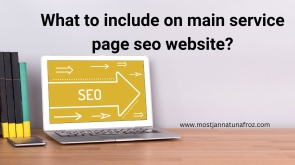Selling a property is a significant milestone, and effectively advertising it can make the process smoother and faster. This guide will walk you through the best strategies how to advertise property for sale?ensuring maximum visibility and interest ...
How Much SEO And SEM Cost In Saudi Arabia?
One of the most frequently asked questions remains: how much seo and sem cost in saudi arabia? In the competitive digital landscape of Saudi Arabia, businesses are increasingly investing in SEO (Search Engine Optimization) and SEM (Search Engin ...
What to include on main service page seo website?
If you query for What to include on main service page seo website? Okay Let' explain. Your main service page is often the first impression potential customers have of your business. This page should clearly convey what you offer, why you’re the best ...
Does Linking All My Sites Help SEO?
As online businesses, portfolios, and brands grow, many website owners start wondering about the benefits of linking their multiple sites together. The question arises: Does linking all my sites help SEO? The simple answer is "it depends." While int ...
How Many Keywords Should I Use for SEO?
In the vast digital landscape, where every click counts, the right keywords can be the beacon that guides potential customers to your website. Understanding how many keywords to use in your SEO strategy is not merely a technical concern; it's a crit ...
Is repeat info on a website bad for seo?
In the competitive world of digital marketing, every business aims to achieve top search engine rankings to attract more visitors and convert them into customers. One key component of optimizing a site for search engines is ensuring high-quality, un ...
How to share google search console access?
If you're running a website or managing SEO for a client, Google Search Console (GSC) is an essential tool. It provides valuable insights into how your website is performing in Google search, helping you identify issues and opportunities to boost yo ...
How to Fix “Page with Redirect” in Google Search Console?
To fix the "Page with Redirect" issue in Google Search Console, you need to identify the redirecting URLs, ensure they lead to the correct destination, and update or remove unnecessary redirects to improve site indexing and SEO. If you manage a w ...
Is a Document SEO Friendly?
In the digital age, creating SEO friendly content is essential for any business or individual aiming to increase their online visibility. Whether it's a blog post, a PDF, a whitepaper, or a presentation, optimizing your documents for SEO can help yo ...
Landing Page Optimization Best Practices (Updated)
Mastering landing page optimization best practices can dramatically improve conversion rates by creating a seamless, user-focused experience that guides visitors toward taking desired actions. Creating effective landing pages is essential for dri ...










